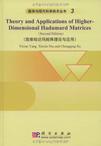高维哈达玛矩阵理论与应用
出版时间:2010-4 出版社:科学出版社 作者:张恭庆 编 页数:489
Tag标签:无
前言
当代数学在向纵深发展的同时,被空前广泛地应用于几乎一切领域。一方面。它与其他学科交汇,形成了许许多多交叉学科(例如,信息科学、计算机科学、系统科学、数学物理、数学化学、生物数学、数学语言学、数量经济学、金融数学、复杂性科学、科学计算等);另一方面,它又被应用于高新技术的开发(例如,信息安全、信息传输、图像处理、语音识别、网络、海量数据处理、网页搜索、遥测遥感、交通管理、医疗诊断、手术方案、药物检验、商业广告等方面),成为一些高新技术的核心。应用数学的这种发展趋势急剧地扩展了数学的疆界,也深刻地改变了数学的面貌。中国的经济正在迅猛发展,其中的科技含量也与日俱增。为了提高自主创新能力,我国已经有不少数学工作者投身于这类应用数学的研究中,还有更多的数学工作者则正在密切关注这方面的进展,看好它的前景。愈来愈多的人希望了解这类应用数学的现状,寻找入门之径。《数学与现代科学技术丛书》是力图反映这个发展趋势的一套应用数学丛书,它将较全面地向我国读者介绍当今数学在现代科学技术各个领域中应用的状况,通过必要的准备知识,逐步把读者引向相关的研究前沿。从事交叉学科研究和高新技术开发的应用数学家,除了要精通所需的数学知识外,还必须深入了解其所研究问题的来龙去脉。“建模”是应用数学研究实际问题的关键。这也是一门数学艺术:从复杂的实际问题中抽象出关键的“量的关系”,使得既能反映出问题的基本特征,又能用现阶段的数学工具加以处理。有鉴于此,这套丛书的一个特点就是:不但要介绍有关的数学理论和方法,还必须介绍问题的来源与背景、数学建模以及如何运用数学工具来解决实际问题。本丛书适用于数学及相关专业的大学生和研究生,以及与数学有关的各专业科技工作者。
内容概要
本书是国际上第一本有关高维哈达玛矩阵及其在电信与信息安全领域中的应用专著《Theory and Applications of Higher Dimensional Hadamard Matrices》的修订版,分为三个部分。第一部分重点研究经典的2维Walsh矩阵和哈达玛矩阵,包括它们的快速算法、最新构造法、存在性结果及其一般性的推广。第二部分考虑的是低维情形,例如,3-维、4-维和6-维Walsh和哈达玛矩阵与变换。第三部分是全书的核心也是本书的独特之处,研究了N-维2阶哈达玛矩阵,并证明了这类矩阵与著名的H-布尔函数和2阶最佳二进阵列是等价的,由此,推导出了一系列有关高维2阶哈达玛矩阵的计数结果。本书中还罗列了许多有关高维哈达玛矩阵理论研究和工程应用的公开问题。
书籍目录
Preface to the Second EditionPreface to the First EditionPart Ⅰ 2-Dimensional Cases Chapter 1 Walsh Matrices 1.1 Walsh Functions and Matrices 1.1.1 Definitions 1.1.2 Ordering 1.2 Orthogonality and Completeness 1.2.1 Orthogonality 1.2.2 Completeness 1.3 Walsh Transforms and Fast Algorithms 1.3.1 Walsh-Ordered Walsh-Hadamard Transforms 1.3.2 Hadamard-Ordered Walsh-Hadamard Transforms Bibliography Chapter 2 Hadamard Matrices 2.1 Definitions 2.1.1 Hadamard Matrices 2.1.2 Hadamard Designs 2.1.3 Williamson Matrices 2.2 Construction 2.2.1 General Constructions 2.2.2 Amicable Hadamard Matrices 2.2.3 Skew Hadamard Matrices 2.2.4 Symmetric Hadamard Matrices 2.3 Existence 2.3.1 Orth0gonal Designs and Hadamard Matrices 2.3.2 Existence Results BibliographyPart Ⅱ Lower-Dimensional Cases Chapter 3 3-Dimensional Hadamard Matrices 3.1 Definitions and Constructions 3.1.1 Definitions 3.1.2 Constructions Based on Direct Multiplications 3.1.3 Constructions Based on 2-Dimensional Hadamard Matrices 3.2 3-Dimensional Hadamard Matrices of Order 4k + 2 3.3 3-Dimensional Hadamard Matrices of Order 4k 3.3.1 Recursive Constructions of Perfect Binary Arrays 3.3.2 Quasi-Perfect Binary Arrays 3.3.3 3-Dimensional Hadamard Matrices Based on PBA(2m, 2m) and PBA(3.2m, 3.2m) 3.4 3-Dimensional Walsh Matrices 3.4.1 Generalized 2-Dimensional Walsh Matrices 3.4.2 3-Dimensional Walsh Matrices 3.4.3 3-Dimensional Pan-Walsh Matrices 3.4.4 Analytic Representations Bibliography Chapter 4 Multi-Dimensional Walsh-Hadamard Transforms 4.1 Conventional 2-Dimensional Walsh-Hadamard Transforms 4.1.1 2-Dimensional Walsh-Hadamard Transforms 4.1.2 Definitions of 4-Dimensional Hadamard Matrices 4.2 Algebraic Theory of Higher-Dimensional Matrices 4.3 Multi-Dimensional Walsh-Hadamard Transforms 4.3.1 Transforms Based on 3-Dimensional Hadamard Matrices 4.3.2 Transforms Based on 4-Dimensional Hadamard Matrices 4.3.3 Transforms Based on 6-Dimensional Hadamard Matrices BibliographyPart Ⅲ General Higher-Dimensional Cases Chapter 5 n-Dimensional Hadamard Matrices of Order 2 5.1 Constructions of 2n Hadamard Matrices 5.1.1 Equivalence between 2n Hadamard Matrices and H-Boolean Functions 5.1.2 Existence of H-Boolean Functions 5.1.3 Constructions of H-Boolean Functions 5.2 Enumeration of 2" Hadamard Matrices 5.2.1 Classification of 24 Hadamard Matrices 5.2.2 Enumeration of 25 Hadamard Matrices 5.2.3 Enumeration of General 2n Hadamard Matrices 5.3 Applications 5.3.1 Strict Avalanche Criterion and H-Boolean Functions 5.3.2 Bent Functions and H-Boolean Functions 5.3.3 Reed-Muller Codes and H-Boolean Functions Bibliography Chapter 6 General Higher-Dimensional Hadamard Matrices 6.1 Definitions, Existences and Constructions 6.1.1 n-Dimensional Hadamard Matrices of Order 2k 6.1.2 Proper and Improper n-Dimensional Hadamard Matrices 6.1.3 Generalized Higher-Dimensional Hadamard Matrices 6.2 Higher-Dimensional Hadamard Matrices Based on Perfect Binary Arrays 6.2.1 n-Dimensional Hadamard Matrices Based on PBAs 6.2.2 Construction and Existence of Higher-Dimensional PBAs 6.2.3 Generalized Perfect Arrays 6.3 Higher-Dimensional Hadamard Matrices Based on Orthogonal Designs 6.3.1 Definitions of Orthogonality 6.3.2 Higher-Dimensional Orthogonal Designs 6.3.3 Higher-Dimensional Hadamard Matrices from Orthogonal Designs BibliographyPart Ⅳ Applications to Signal Design and Analysis Chapter 7 Design and Analysis of Sequences 7.1 Sequences of Cryptographic Significance 7.1.1 Enumerating Boolean Functions of Cryptographic Significance 7.1.2 Constructing Boolean Functions of Cryptographic Significance 7.1.3 Correlation Immunity of Boolean Functions 7.1.4 Entropy Immunity of Feedforward Networks 7.2 Correlation Functions of Geometric Sequences 7.2.1 Onthe Correlation Functions of a Family of Gold-Geometric Sequences 7.2.2 On the Correlation Functions of a Family of Generalized Geometric Sequences 7.2.3 On the Correlation Functions of p-Ary d-Form Sequences 7.3 Sequence Pairs with Mismatched Filtering 7.3.1 Binary Sequences Pairs with Two-Level Autocorrelation Functions (BSPT) 7.3.2 Difference Set Pairs 7.3.3 Construction of BSPTs 7.3.4 Periodic Complementary Binary Sequence Pairs 7.4 Sequence Unusual Analysis 7.4.1 Boolean Neural Network Design 7.4.2 Linear Complexity and Random Sequences with Period 2n 7.4.3 Periodic Ambiguity Functions of EQC-Based TFHC 7.4.4 Auto-, Cross-, and Triple Correlations of Sequences Bibliography Chapter 8 Design and Analysis of Arrays 8.1 Costas Arrays 8.1.1 Correlations of Costas Arrays 8.1.2 Algebraically Constructed Costas Arrays 8.1.3 Enumeration Limitation of Costas Arrays 8.2 Optical Orthogonal Codes 8.2.1 Parameters Bounds of Optical Orthogonal Codes 8.2.2 Truncated Costas Optical Orthogonal Codes BibliographyConcluding QuestionsIndex
章节摘录
插图:
编辑推荐
《高维哈达玛矩阵理论与应用》由科学出版社出版。
图书封面
图书标签Tags
无
评论、评分、阅读与下载
